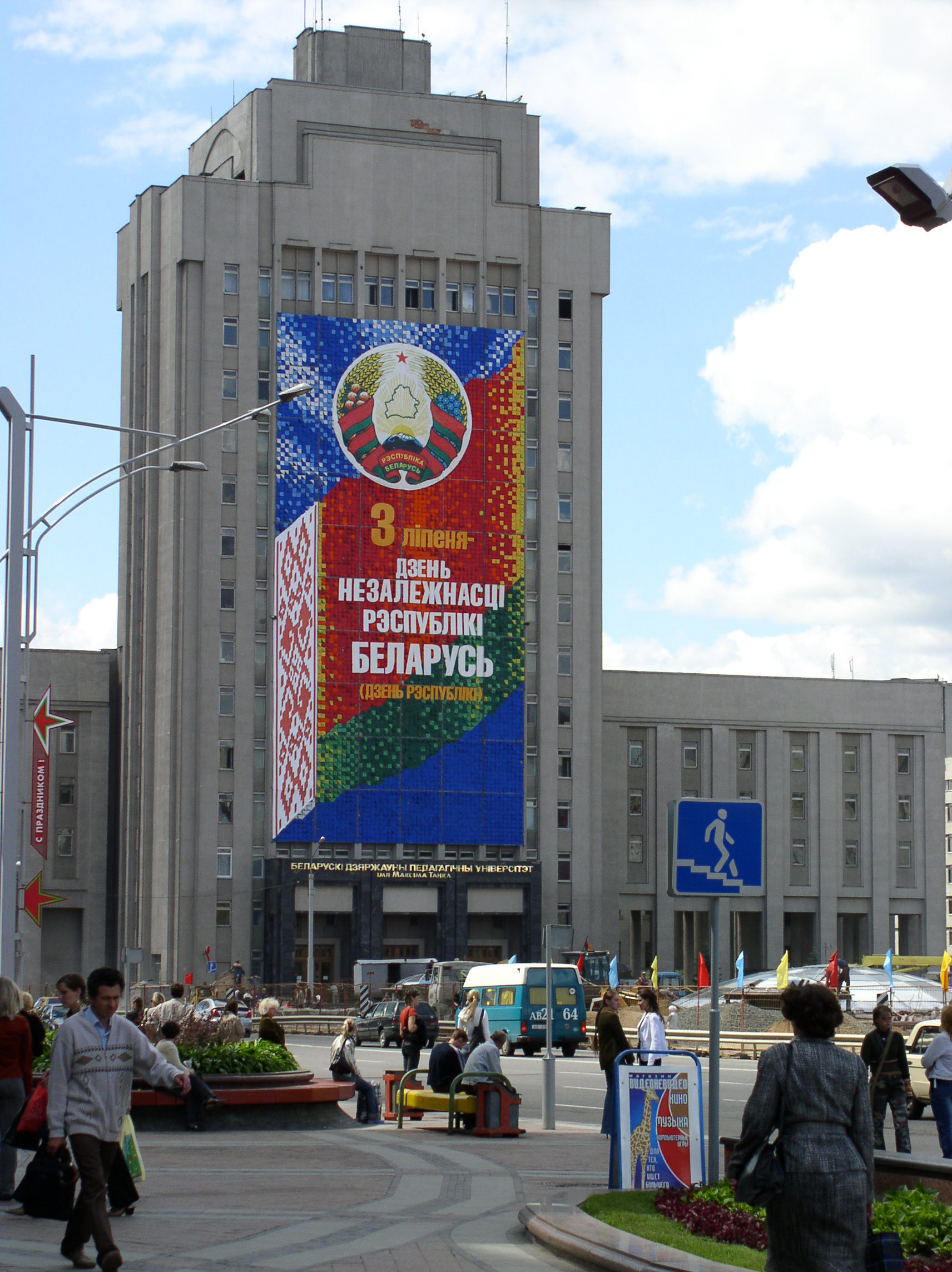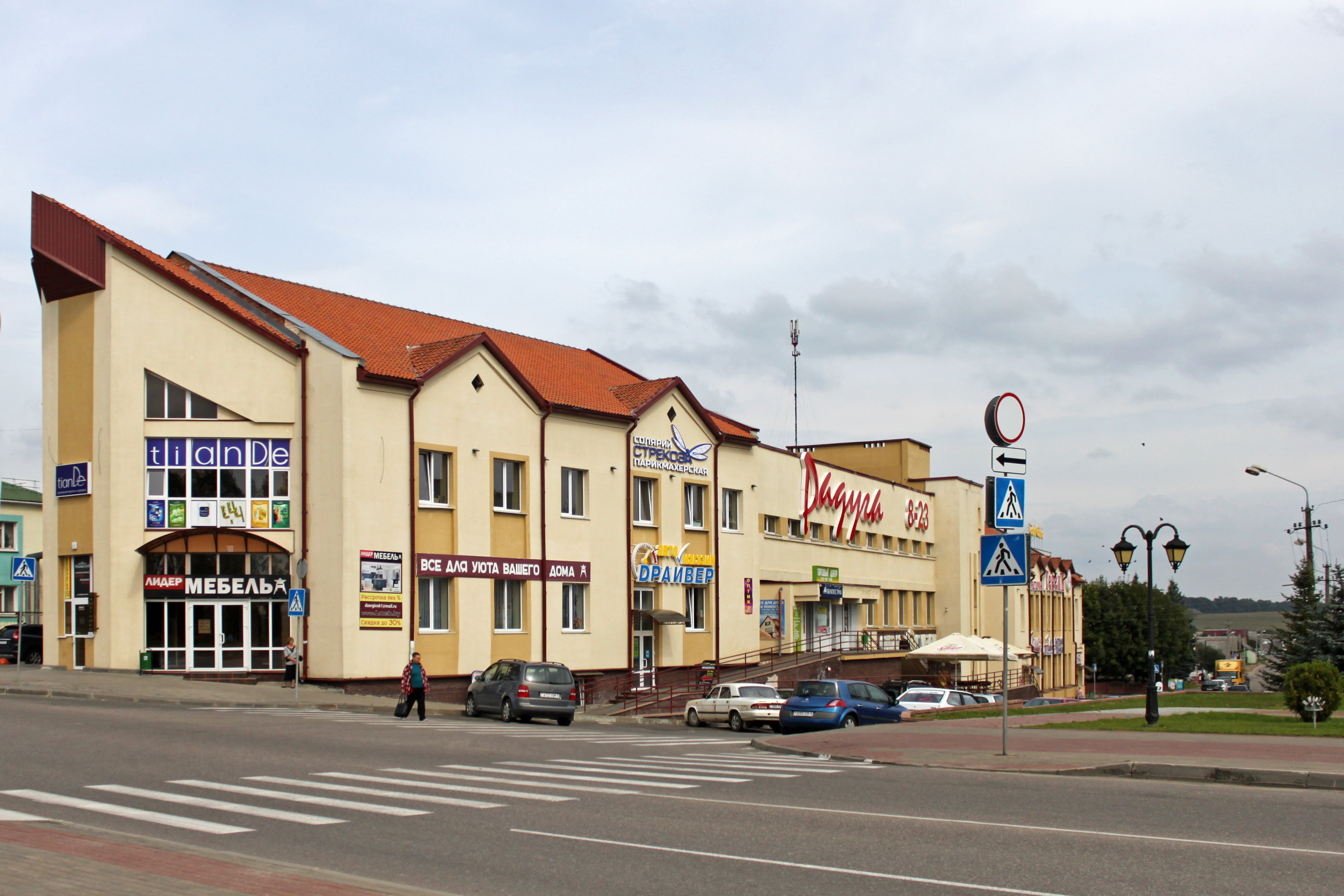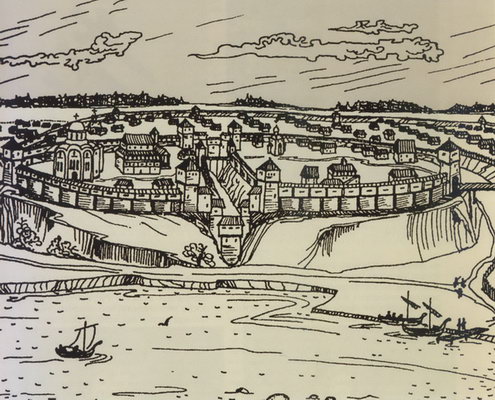|
Independence Day (Belarus)
Independence Day of the Republic of Belarus ( be, –Ф–Ј–µ–љ—М –Э–µ–Ј–∞–ї–µ–ґ–љ–∞—Б—Ж—Ц –†—Н—Б–њ—Г–±–ї—Ц–Ї—Ц –С–µ–ї–∞—А—Г—Б—М, russian: –Ф–µ–љ—М –Э–µ–Ј–∞–≤–Є—Б–Є–Љ–Њ—Б—В–Є –†–µ—Б–њ—Г–±–ї–Є–Ї–Є –С–µ–ї–∞—А—Г—Б—М), also known as Republic Day or Liberation Day is a public holiday, the independence day of Belarus and is celebrated each year on 3 July. Independence Day is a non-working day. History 3 July 1944 was the day of Soviet liberation of Minsk from the Wehrmacht during the Minsk Offensive (code-named "Bagration"). The decision to celebrate Independence Day on 3 July, the day of the liberation of Belarus from the Nazis, from 27 July, the day of the Declaration of Sovereignty of Belarus in breaking away from the Soviet Union, was made during a controversial national referendum held in 1996 proposed by President Alexander Lukashenko. Prior to the 1996 change, July 3 was celebrated locally in Minsk as simply Minsk Day. Since waves of unrest began in Central and Eastern Europe ... [...More Info...] [...Related Items...] OR: [Wikipedia] [Google] [Baidu] |
Belarus
Belarus,, , ; alternatively and formerly known as Byelorussia (from Russian ). officially the Republic of Belarus,; rus, –†–µ—Б–њ—Г–±–ї–Є–Ї–∞ –С–µ–ї–∞—А—Г—Б—М, Respublika Belarus. is a landlocked country in Eastern Europe. It is bordered by Russia to the east and northeast, Ukraine to the south, Poland to the west, and Lithuania and Latvia to the northwest. Covering an area of and with a population of 9.4 million, Belarus is the 13th-largest and the 20th-most populous country in Europe. The country has a hemiboreal climate and is administratively divided into seven regions. Minsk is the capital and largest city. Until the 20th century, different states at various times controlled the lands of modern-day Belarus, including Kievan Rus', the Principality of Polotsk, the Grand Duchy of Lithuania, the PolishвАУLithuanian Commonwealth, and the Russian Empire. In the aftermath of the Russian Revolution in 1917, different states arose competing for legitimacy amid the ... [...More Info...] [...Related Items...] OR: [Wikipedia] [Google] [Baidu] |
Hienadz Buraukin
Hienadz Buraukin ( be, –У–µ–љ–∞–і–Ј—М –С—Г—А–∞—Ю–Ї—Ц–љ, 28 August 1936 вАУ 30 May 2014) was a Belarusian poet, journalist and diplomat. Biography He was born in the village Shuliacina in Vitebsk Region. In 1959, he graduated from the Belarusian State University. During his career, he was chief reporter of the Soviet state newspaper Pravda in Belarus. In 1969, he helped Zianon Pazniak to publish several articles on preservation of architectural heritage of Belarus. From 1972 to 1978, Buraukin was chief editor of the Belarus-wide magazine Maladosts, where he published numerous works of Vasil Byka≈≠ and Uladzimir Karatkievich. Being member of the parliament from 1980 to 1990, he was one of the promoters of a law that improved the status of the Belarusian language in BSSR. From 1978 to 1990, he was chief of State Television and Radio-company of Belarus, but was dismissed from the position for granting broadcasting possibilities for members of the democratic opposition. From 199 ... [...More Info...] [...Related Items...] OR: [Wikipedia] [Google] [Baidu] |
Dzyarzhynsk
Dzyarzhynsk or Dzerzhinsk, formerly Koidanova or Koydanava ( be, –Ф–Ј—П—А–ґ—ЛћБ–љ—Б–Ї, Dziar≈Њynsk, formerly , ; russian: –Ф–Ј–µ—А–ґ–ЄћБ–љ—Б–Ї, Dzerzhinsk, formerly , ; pl, Kojdan√≥w; yi, „І„Х„Щ„У„Р÷Ј„†„Р÷Є„Х„Х, Koydanov; lt, Kaidanava), in the Dzyarzhynsk District of Belarus, is a city with a history dating to the 11th century. History In the Middle Ages, the village belonged to the Radziwi≈В≈Вs, a PolishвАУLithuanian aristocratic family. Jewish community Jews lived in Koidanova as early as 1620. Koidanova became the site of a new Hasidic Jewish dynasty in 1833 when Rabbi Shlomo Chaim Perlow (1797вАУ1862) became the first Koidanover Rebbe. He was succeeded by his son, Rabbi Boruch Mordechai Perlow (1818–1870), grandson, Rabbi Aharon Perlow (1839–1897), and great-grandson, Rabbi Yosef Perlow of Koidanov-Minsk (1854-1915), who was the last Koidanover Rebbe to live in the town. After World War I, the dynasty was moved to Baranovichi, then in Poland. In 1847, K ... [...More Info...] [...Related Items...] OR: [Wikipedia] [Google] [Baidu] |
Brest, Belarus
Brest ( be, –С—А—Н—Б—В / –С–µ—А–∞—Б—М—Ж–µ, Biera≈Ыcie, ; russian: –С—А–µ—Б—В, ; uk, –С–µ—А–µ—Б—В—П, Berestia; lt, Brasta; pl, Brze≈ЫƒЗ; yi, „С„®„Щ„°„І, Brisk), formerly Brest-Litovsk (russian: –С—А–µ—Б—В-–Ы–Є—В–Њ–≤—Б–Ї, lit=Lithuanian Brest; be, links=no, translit=Berastze Litouski (Berastze), –С–µ—А–∞—Б—Ж–µ –Ы—Ц—В–Њ—Ю—Б–Ї—Ц (–С–µ—А–∞—Б—Ж–µ); lt, links=no, Lietuvos Brasta; pl, links=no, Brze≈ЫƒЗ Litewski, ), Brest-on-the-Bug ( pl, links=no, Brze≈ЫƒЗ nad Bugiem), is a city (population 350,616 in 2019) in Belarus at the border with Poland opposite the Polish city of Terespol, where the Bug and Mukhavets rivers meet, making it a border town. It is the capital city of the Brest Region. Brest is a historical site for many cultures, as it hosted important historical events, such as the Union of Brest and Treaty of Brest-Litovsk. Furthermore, the Brest Fortress was recognized by the Soviet Union as a Hero Fortress in honour of the defense of Brest Fortress in June 19 ... [...More Info...] [...Related Items...] OR: [Wikipedia] [Google] [Baidu] |
Gomel
Gomel (russian: –У–Њ–Љ–µ–ї—М, ) or Homiel ( be, –У–Њ–Љ–µ–ї—М, ) is the administrative centre of Gomel Region and the second-largest city in Belarus with 526,872 inhabitants (2015 census). Etymology There are at least six narratives of the origin of the city's name. The most plausible is that the name is derived from the name of the stream Homeyuk, which flowed into the river Sozh near the foot of the hill where the first settlement was founded. Names of other Belarusian cities are formed along these lines: for example, the name Minsk is derived from the river Menka, Polatsk from the river Palata, and Vitsebsk from the river Vitsba. The first appearance of the name, as "Gomy", dates from 1142. Up to the 16th century, the city was mentioned as Hom', Homye, Homiy, Homey, or Homyi. These forms are tentatively explained as derivatives of an unattested ''*gom≈≠'' of uncertain meaning. The modern name for the city has been in use only since the 16th or 17th centuries. History U ... [...More Info...] [...Related Items...] OR: [Wikipedia] [Google] [Baidu] |
Barysaw
Barysaw ( be, –С–∞—А—Л—Б–∞—Ю, ) or Borisov (russian: –С–Њ—А–Є—Б–Њ–≤, ) is a city in Belarus near the Berezina River in the Minsk Region 74 km north-east from Minsk. Its population is around 145,000. History Barysaw is first mentioned in the Laurentian Codex as being founded (as Borisov) in 1102 by the Prince of Polotsk Rogvolod Vseslavich, who had the baptismal name of Boris. During the next two centuries, it was burned and then rebuilt south of where it was before. Half a millennium as part of Lithuania From the late 13th century to 1795, the town was part of the Grand Duchy of Lithuania, which was itself involved in many unions вАУ the Union of Krewo (1385) and Union of Lublin (1569). In 1500, during the LithuanianвАУMuscovite War, Alexander Jagiellon resided in Barysaw Castle. In 1563, it was granted Magdeburg town rights by King Sigismund II Augustus. 1790s In the last years of the Polish-Lithuanian Commonwealth, troops were stationed here, including the ... [...More Info...] [...Related Items...] OR: [Wikipedia] [Google] [Baidu] |
Belarusian Armed Forces
The Armed Forces of the Republic of Belarus (, ) consist of the Ground Forces and the Air Force and Air Defence Forces, all under the command of the Republic of Belarus Ministry of Defence. Being a landlocked country, Belarus has no navy. In 2017 the IISS estimated that personnel in the armed forces numbered 48,000. Most soldiers are conscripts serving for a period of 18 months, although there is an alternative service option. Belarus conducted military reforms in the early 2000s which reshaped its armed forces as a relatively effective force for a small state in somewhat difficult economic conditions. History The previous Belarusian People's Republic of March 1918 to 1919 did not have time to create armed forces in its brief existence, although attempts to create a military have been documented. Until 1991 the Soviet Belorussian Military District comprised the 5th Guards Tank Army (HQ Bobruisk), the 7th Tank Army (HQ Borisov), the 28th Army (HQ Grodno), the 120th Guards M ... [...More Info...] [...Related Items...] OR: [Wikipedia] [Google] [Baidu] |
Freedom Day (Belarus)
Freedom Day ( be, –Ф–Ј–µ–љ—М –Т–Њ–ї—Ц, ''Dzie≈Д Voli'') is an unofficial holiday in Belarus celebrated on 25 March to commemorate the declaration of independence by the Belarusian Democratic Republic by the Third Constituent Charter on that date in 1918. It is also known as the 25-aha sakavika (, March 25th) day. Freedom Day has been celebrated as the Independence Day of Belarus by the Belarusian independence movement since the early 1920s. It is widely celebrated by the Belarusian diaspora. In the United States, governors and US presidents, including Dwight Eisenhower, Ronald Reagan, George H. W. Bush and Bill Clinton, have traditionally issued official greetings to the Belarusian American community on 25 March. The Belarusian opposition to the dictatorial regime of Alexander Lukashenko celebrates Freedom Day annually. The protests in Belarus are regularly accompanied by mass detention and torture of the protesters. The government does not recognize Freedom Day claiming ... [...More Info...] [...Related Items...] OR: [Wikipedia] [Google] [Baidu] |
Belarusian Democratic Republic
The Belarusian People's Republic (BNR; be, –С–µ–ї–∞—А—Г—Б–Ї–∞—П –Э–∞—А–Њ–і–љ–∞—П –†—Н—Б–њ—Г–±–ї—Ц–Ї–∞, Bielaruskaja Narodnaja Respublika, ), or Belarusian Democratic Republic, was a state proclaimed by the Council of the Belarusian Democratic Republic in its Second Constituent Charter on 9 March 1918 during World War I. The Council proclaimed the Belarusian Democratic Republic independent in its Third Constituent Charter on 25 March 1918 during the occupation of contemporary Belarus by the Imperial German Army. The government of the Belarusian Democratic Republic never had power over the whole territory of Belarus. In 1919, it co-existed with an alternative Communist government of Belarus (the Socialist Soviet Republic of Byelorussia, which later became part of the LithuanianвАУByelorussian Soviet Socialist Republic), moving its seat of government to Vilnius and Grodno, but ceased to exist due to the capture of the whole Belarusian territory by Polish and Socialist Soviet R ... [...More Info...] [...Related Items...] OR: [Wikipedia] [Google] [Baidu] |
Belarusian Diaspora
The Belarusian diaspora refers to emigrants from the territory of Belarus as well as to their descendants. According to different researchers, there are between 2.5 and 3.5 million Belarusian descendants living outside the territory of the Republic of Belarus. This number includes descendants of economic emigrants from Belarus in the late 19th and early 20th centuries, Second World War-era emigrants and the 1990s-present period of emigration. Another part of the Belarusian diaspora are people who migrated within the USSR before 1991 and who after its dissolution became inhabitants of other post-Soviet countries. A separate faction usually associated with the Belarusian diaspora are ethnic minorities in the borderlands of Belarus with Poland, Lithuania, Latvia, Russia and Ukraine. A separate group of emigrants from Belarus are Belarusian Jews who have established significant communities in the United States and Israel. There is a tendency to underestimate the number of people ... [...More Info...] [...Related Items...] OR: [Wikipedia] [Google] [Baidu] |
Dissolution Of The Soviet Union
The dissolution of the Soviet Union, also negatively connoted as rus, –†–∞–Ј–≤–∞ћБ–ї –°–Њ–≤–µћБ—В—Б–Ї–Њ–≥–Њ –°–Њ—ОћБ–Ј–∞, r=Razv√°l Sov√©tskogo Soy√Їza, ''Ruining of the Soviet Union''. was the process of internal disintegration within the Soviet Union (USSR) which resulted in the end of the country's and its federal government's existence as a sovereign state, thereby resulting in its constituent republics gaining full sovereignty on 26 December 1991. It brought an end to General Secretary Mikhail Gorbachev's (later also President) effort to reform the Soviet political and economic system in an attempt to stop a period of political stalemate and economic backslide. The Soviet Union had experienced internal stagnation and ethnic separatism. Although highly centralized until its final years, the country was made up of fifteen top-level republics that served as homelands for different ethnicities. By late 1991, amid a catastrophic political crisis, with several republics alr ... [...More Info...] [...Related Items...] OR: [Wikipedia] [Google] [Baidu] |




.jpg)
.png)

.jpg)